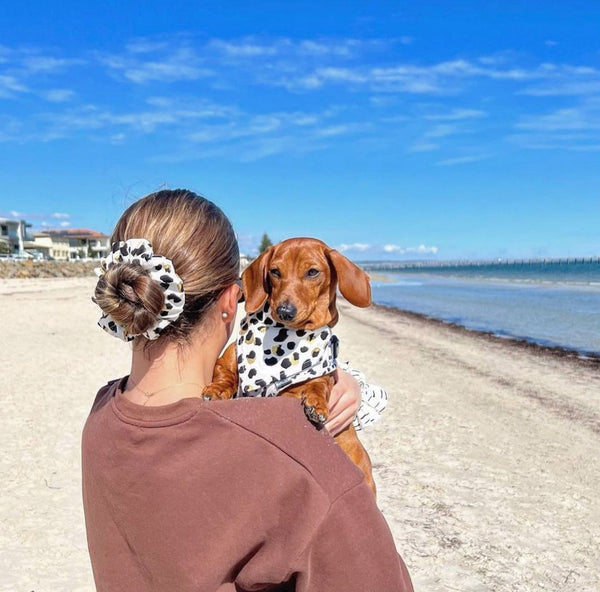AFTERPAY NOW AVAILABLE | CHRISTMAS SALES 30% OFF STORE WIDE - CODE "XMAS30"
AFTERPAY NOW AVAILABLE | CHRISTMAS SALES 30% OFF STORE WIDE - CODE "XMAS30"

Salt in the air, sand in my hair. It’s that time of the year again, and it looks like someone’s excited for the summer beach adventure—your fur baby who can’t stop wagging his tail all day!
The beach is the perfect place to have fun, especially when you have the perfect beach body. I mean buddy! Dogs are simply the biggest beach bums. They love digging the soft sands, chasing waves twice their size, and basking in the warmth of the sun and the company of their favourite human.
But like any place, beaches expose people and dogs to hazards like hot sand, crowds, and even big waves. As fur parents, we have to protect dogs during beach walks. So, plan well, prepare everything in your MAMA dog bag, and learn these safety tips for walking your dog to the beach.
Don’t let sunburns take the fun away. Seas the day!

Keep your dog’s safety in mind before everything else. To keep your dog safe while having fun on the beach, make sure to take these safety tips to heart:
A day on the beach entails lots of off-leash activities. Without a reliable recall, your fur baby might be too distracted to listen to you, increasing the likelihood of getting lost or in trouble.
Besides recall, it’ll be helpful to socialise your dog and have him learn off-leash etiquette and the following commands before going to the beach:
Apart from paw burns caused by the hot sand, dogs under extremely hot weather may also experience heatstroke—a serious, sometimes fatal illness. Considering that the sun peaks from noon to 2 p.m., having your fur baby beach walking before or after the said period is best.
Like humans, dogs can also get sunburns. Hence, they need sunscreens on their nose, ears, and any body part that’s pink and hairless for sun protection. But make sure that it’s the right one! Sunblocks for humans usually contain zinc oxide or para-aminobenzoic acid (PABA), which are highly toxic to dogs.
Dogs typically need about 1 ounce of water per pound of body weight daily. But this amount varies based on your dog’s activities. Swimming and running around the beach
Being naturally curious, dogs would likely smell or eat new things, including seawater! But you must know that ingesting salt water can cause diarrhea, vomiting, and dehydration in dogs as salt drains water from the body, and sodium disrupts your dog's fluid balance.
If left unattended, this can be fatal, with over 50% mortality rate. So, if you suspect saltwater ingestion, promptly seek veterinary care for your dog. You can also prevent this by taking a break from the water every 15 minutes.
Dogs make the silliest faces and have the most fun when they swim—at least the dogs you saw on the internet. In reality, swimming isn’t for all fur babies. Some might be more comfortable playing in the sand or enjoying just a few water splashes.
So, if your dog’s one of the latter type, don’t force him to swim. It'll only make him fear water or panic and struggle to keep his head afloat.
Before letting your dog swim, check tide charts in Sydney beaches or wherever region you may be. It’s also helpful to have dogs wear life jackets or practice swimming in controlled environments so they won’t be too startled by beach waters.
Always carry a dog first-aid kit and your MAMA dog bag for pet essentials on the beach. With these, you can immediately respond to your dog’s injuries or scoop up their dirt with your poop bag rolls.

Beach dangers can be sneaky. Your dog could be enjoying themselves one moment, and the next, they might encounter wildlife or even suffer from heatstroke.
So, be vigilant about the following at the beach:
Familiarise beach rules and signages
Some beaches or swimming areas don't allow dogs; others have set times and specific leash laws. So, it’s best to research dog-friendly beaches in your area first and always carry your dog’s leash in case your dog’s not allowed to go off-leash.
Watch out for signs of saltwater poisoning
While excessive saltwater consumption can lead to vomiting within hours, some affected dogs may not vomit but experience the following symptoms instead:
Heatstroke happens when your dog’s internal body temperature overcomes your dog’s capacity to release heat. In this case, temperature exceeds the normal range of 38.3 to 39.2°C.
It’s life-threatening and must be addressed immediately. So, here are some symptoms that you should watch out for:
For severe cases of heatstroke, dogs exhibit the following:
Saltwater, sand, and other beach elements can irritate your dog's eyes. Supervise your dog to prevent them from running into the sand, being hit by waves, or anything that might put irritants in their eyes.
You could also have them wear doggles matching their other accessories, like harnesses, bandanas, and hair bows.
Sandy cheeks and salty kisses might look cute on your pup, but these could turn into infections and itch after some time. So, after a day of sun, sand, and sea, your furry companion deserves special post-beach care.
Remember to plan, respect beach rules and regulations, watch your dog, provide shade and fresh water, and be considerate of other beachgoers. These precautions will not only protect your dog from potential hazards but also help preserve the beauty of our coastal environments for everyone to enjoy.
So, grab your sunscreen, pack your beach gear, and embark on a safe and fantastic beach adventure with your four-legged family member!